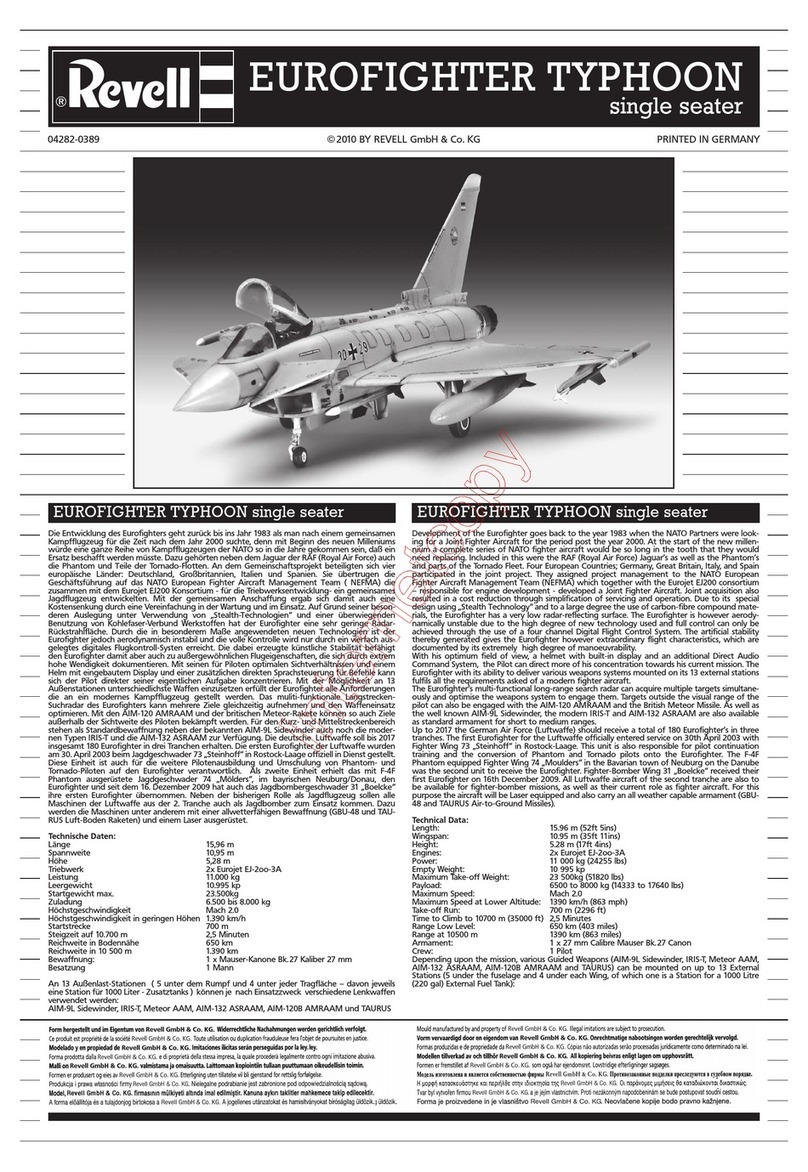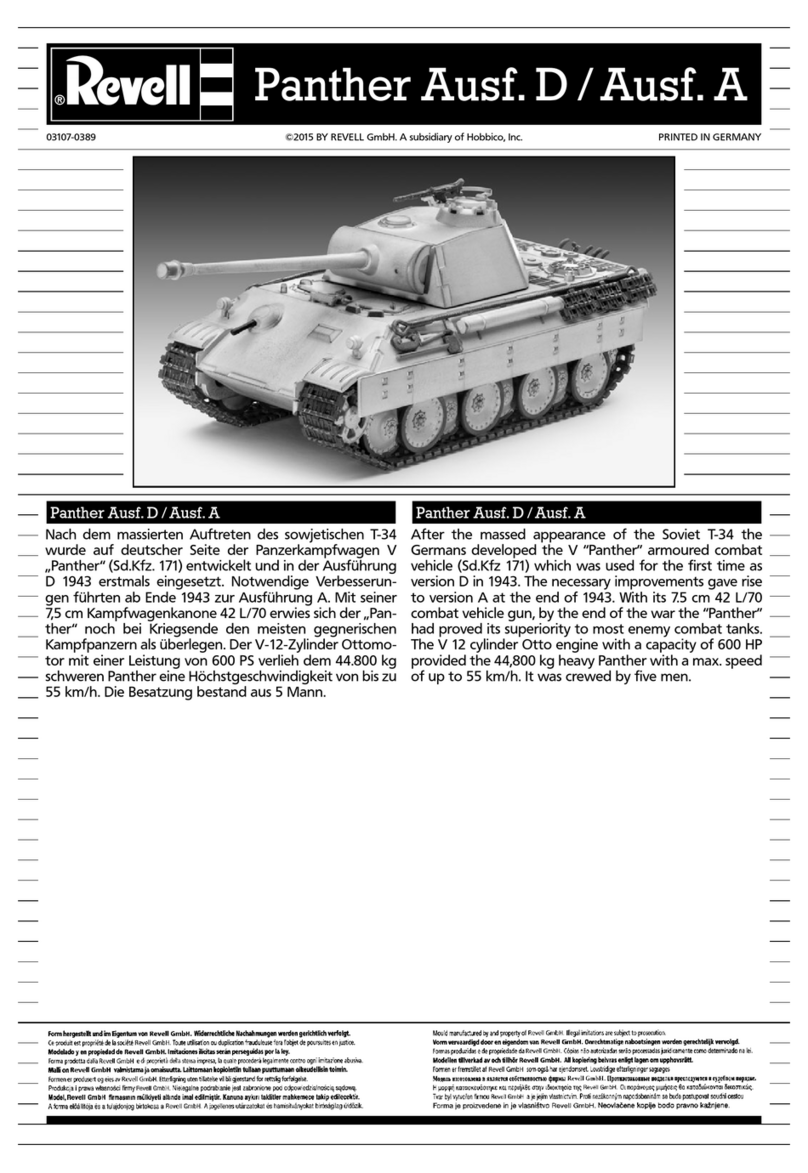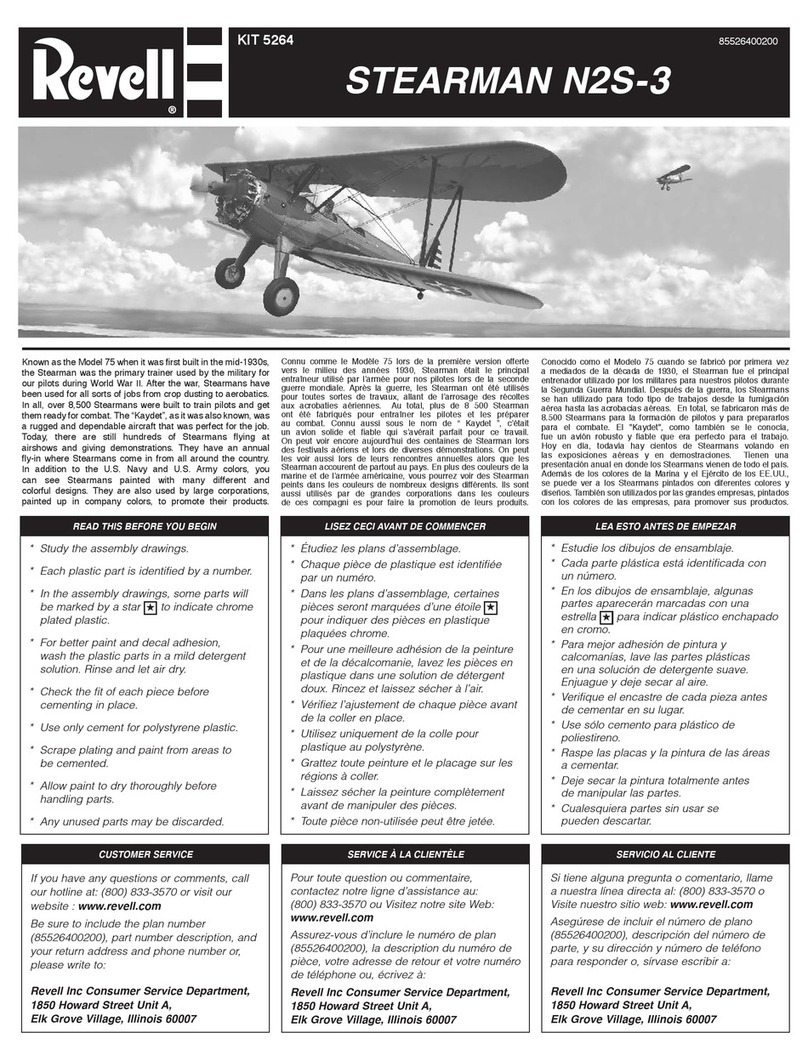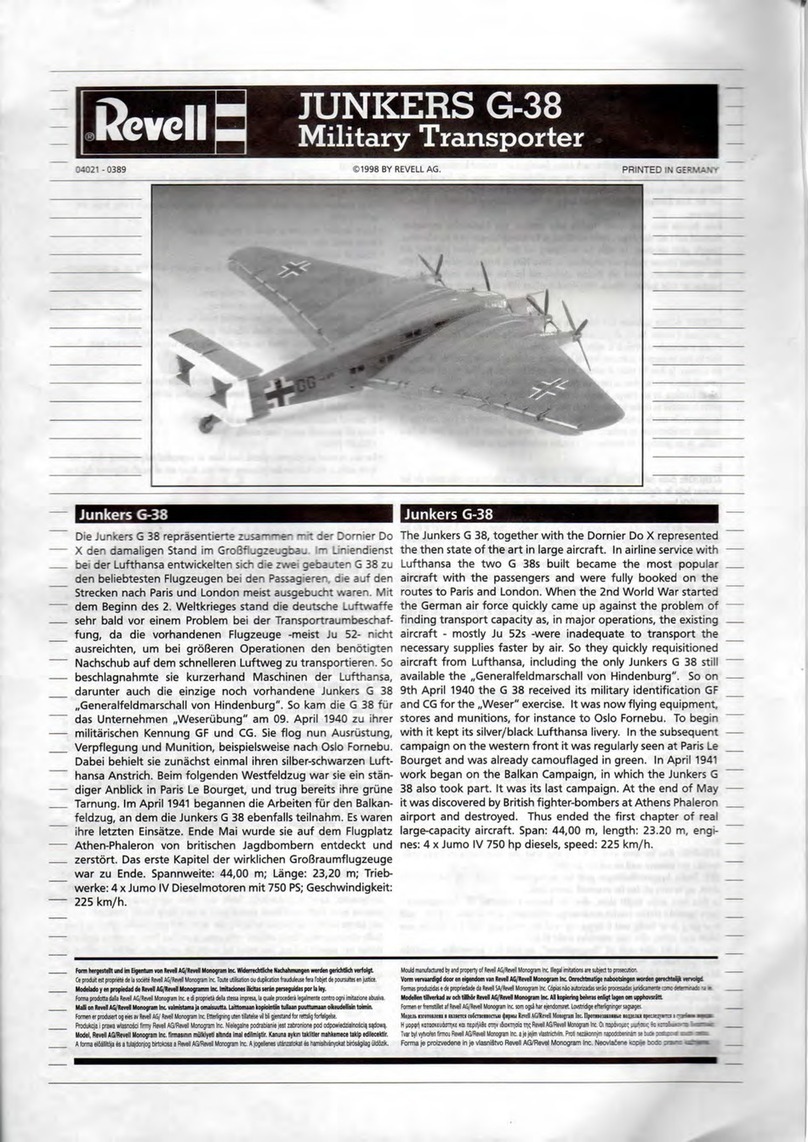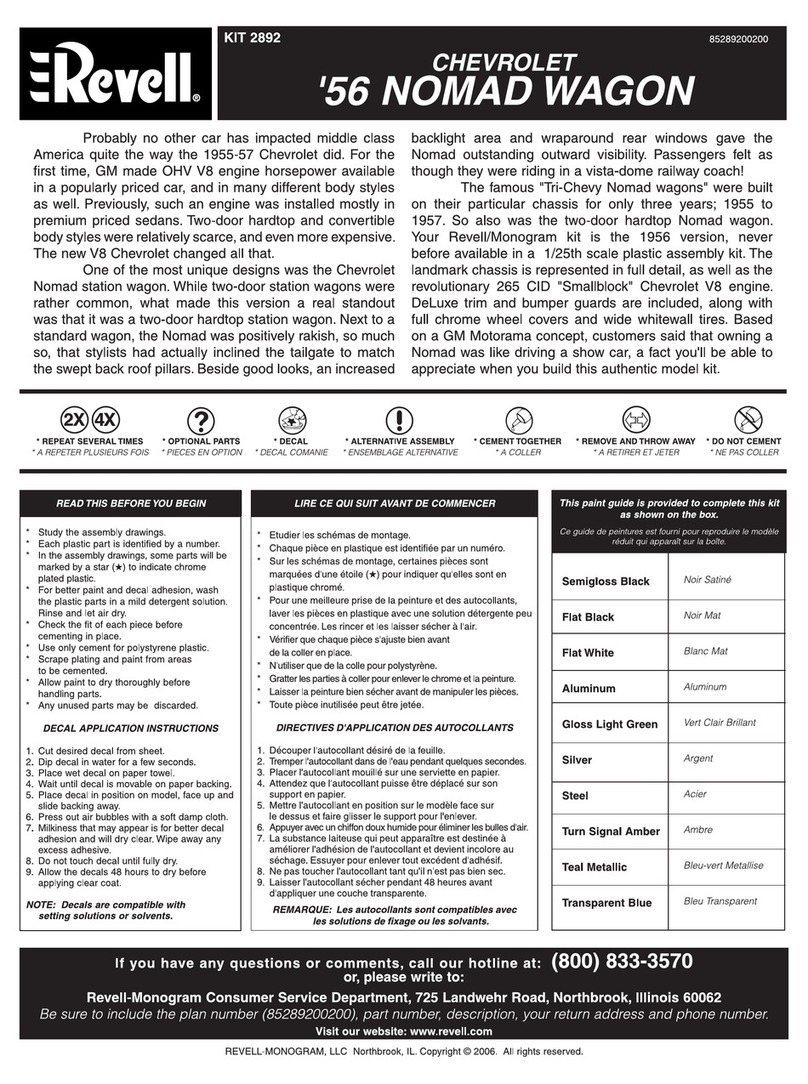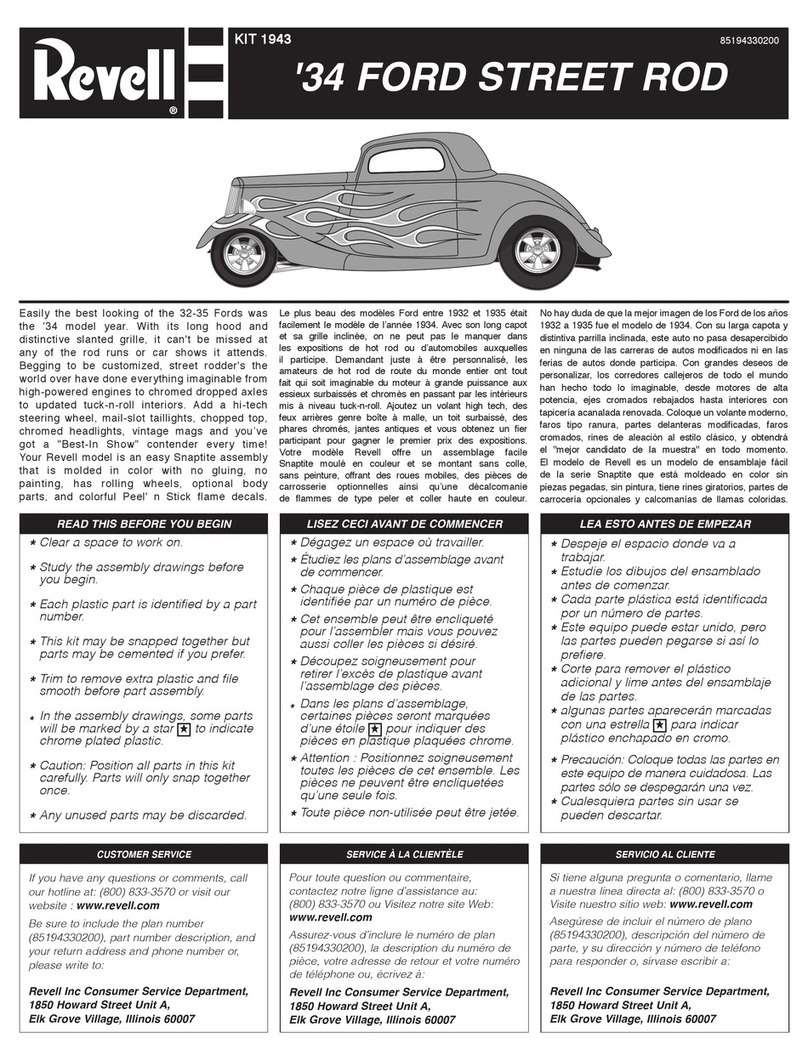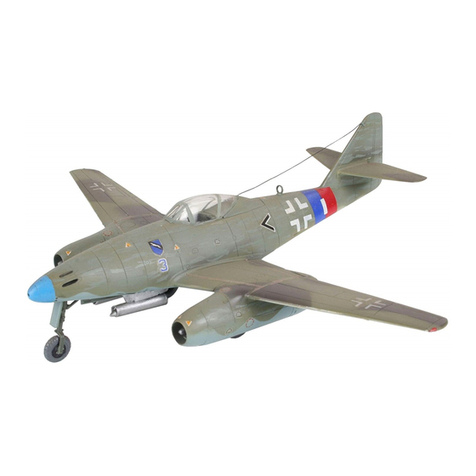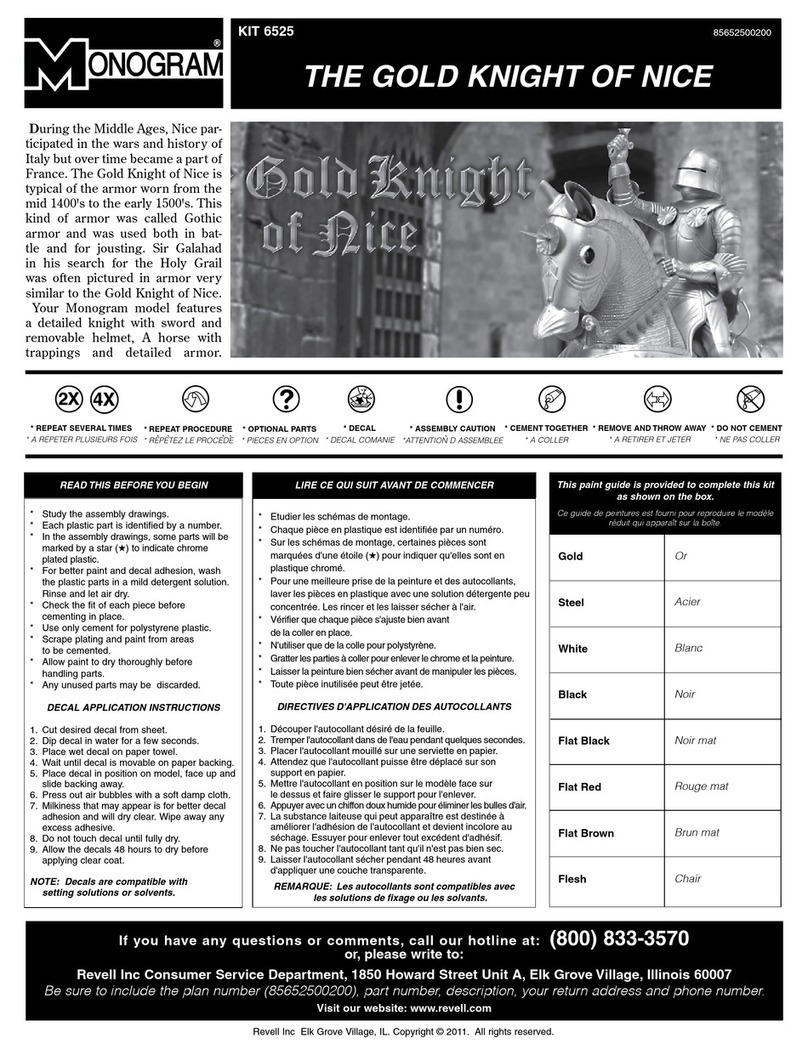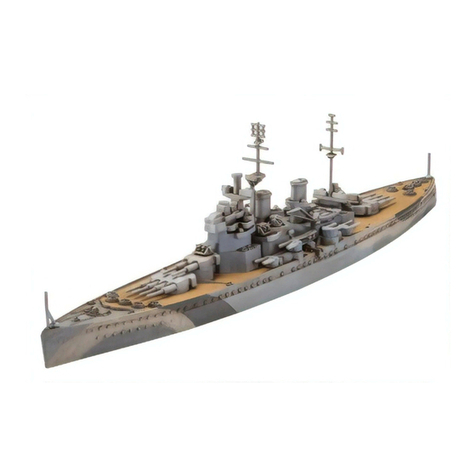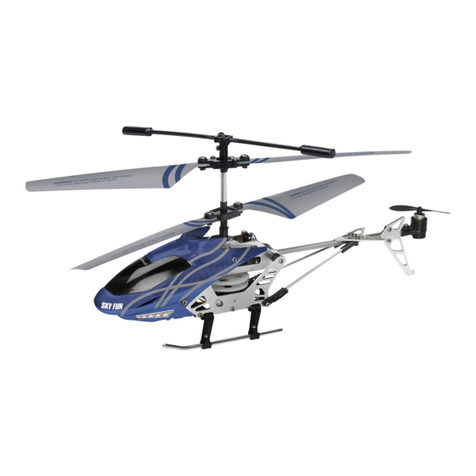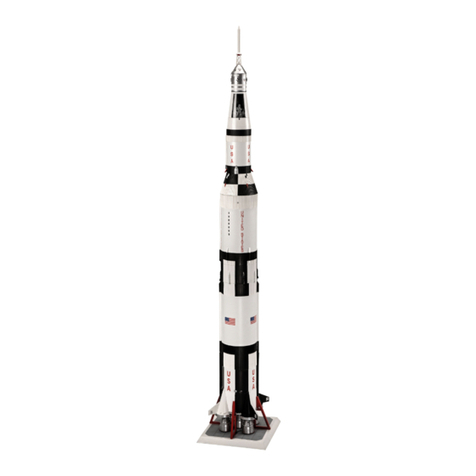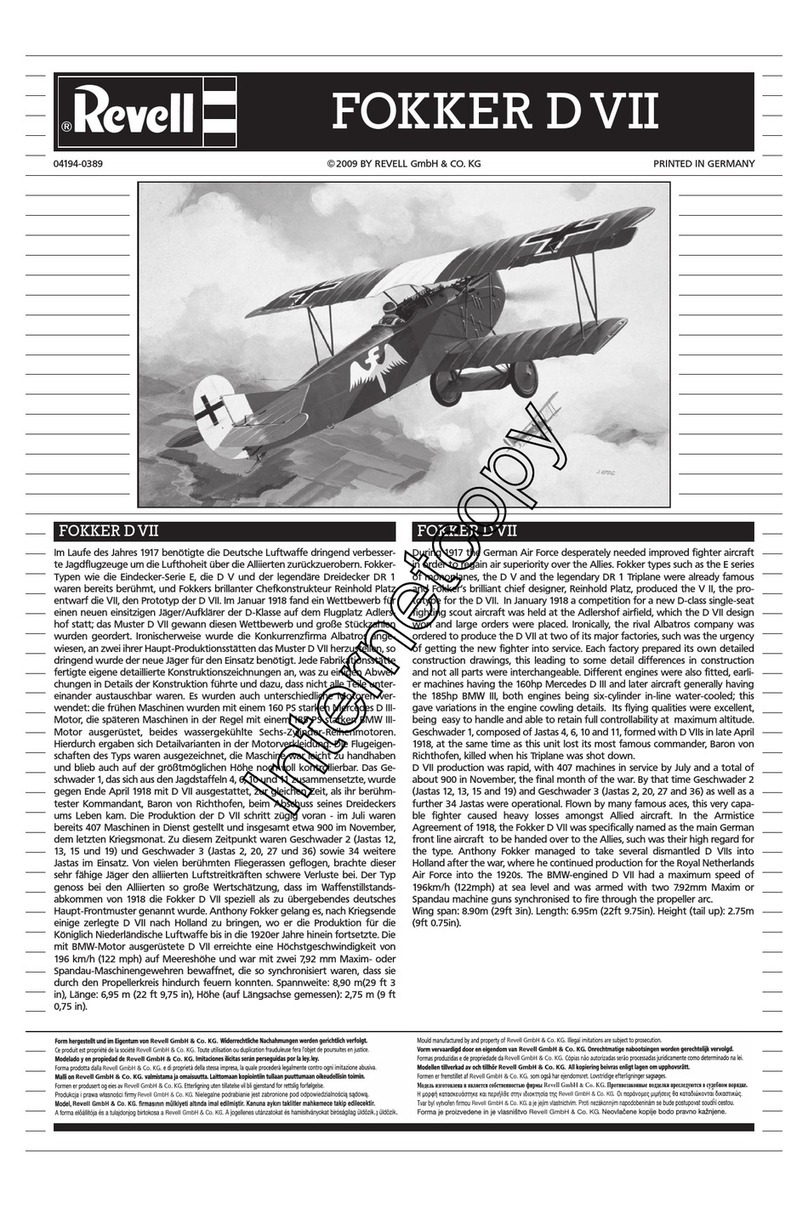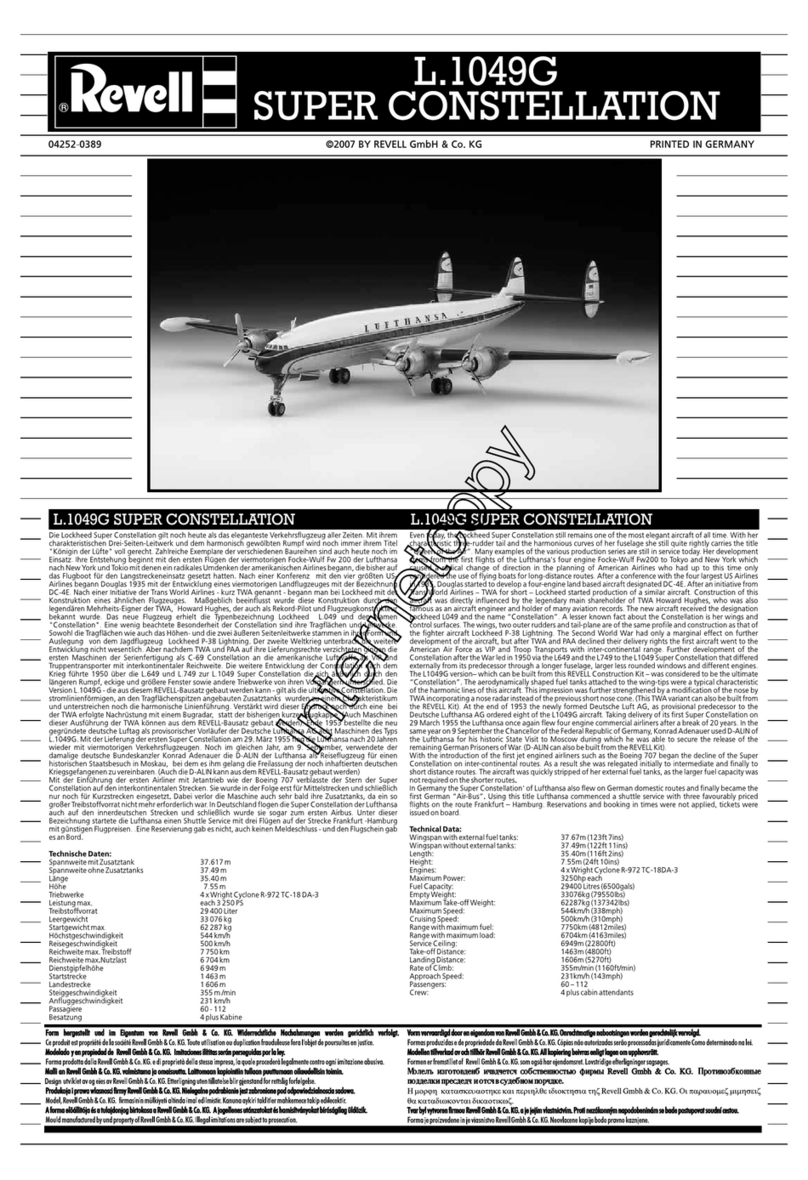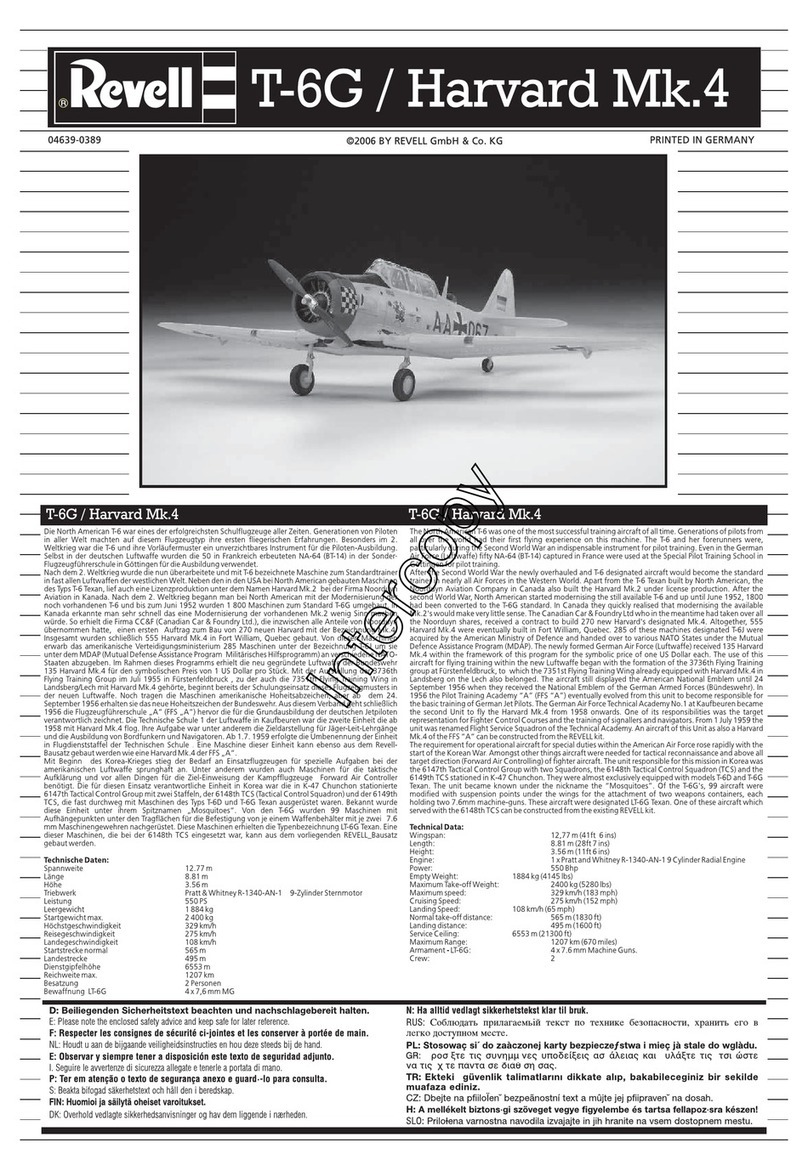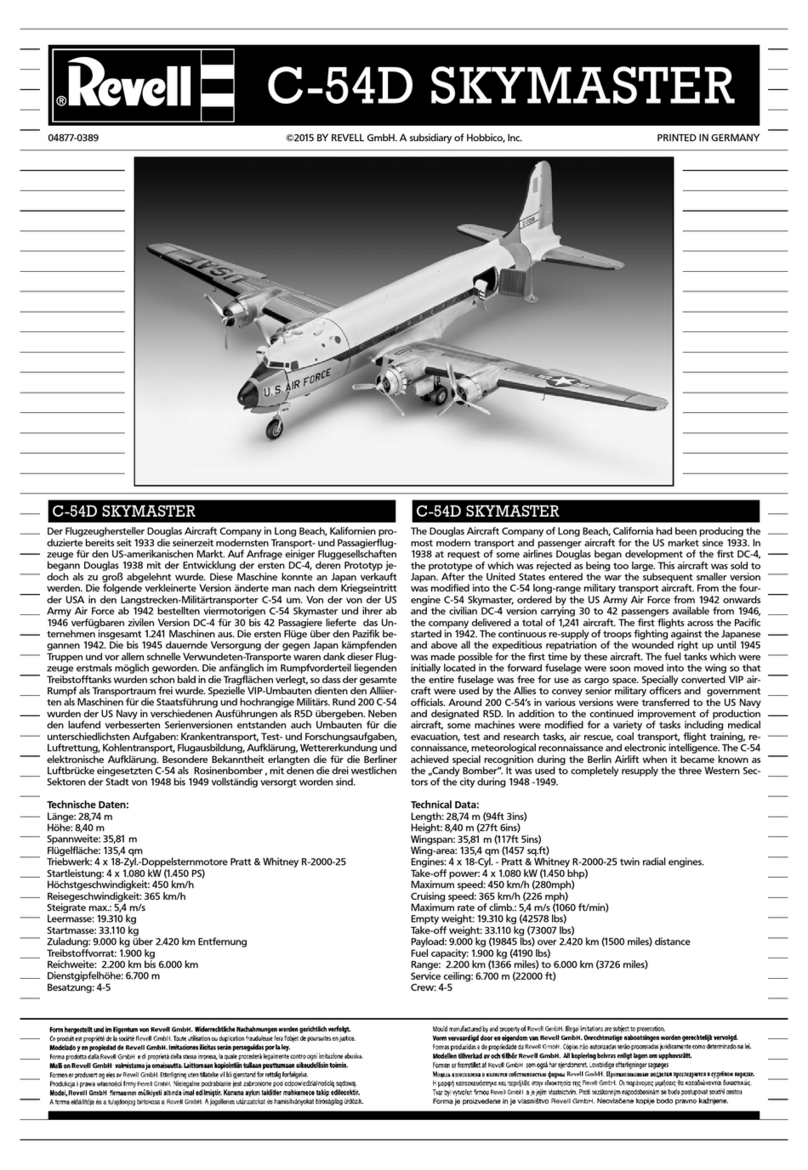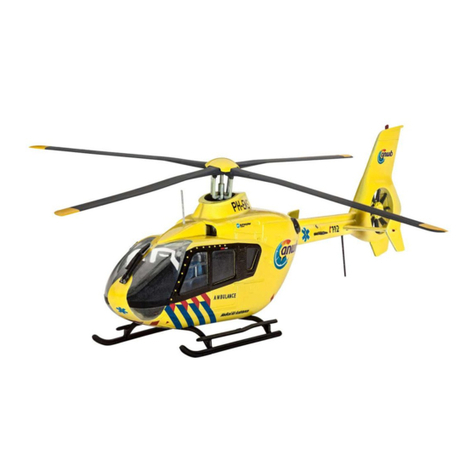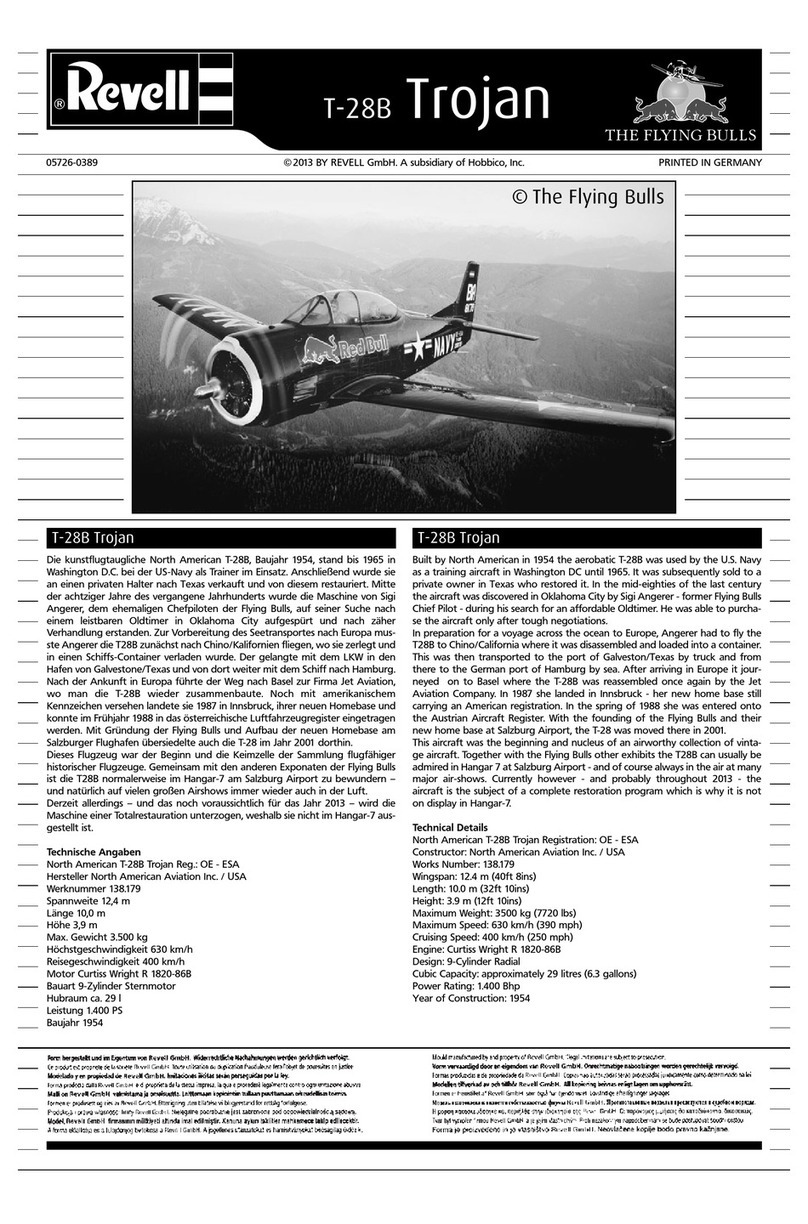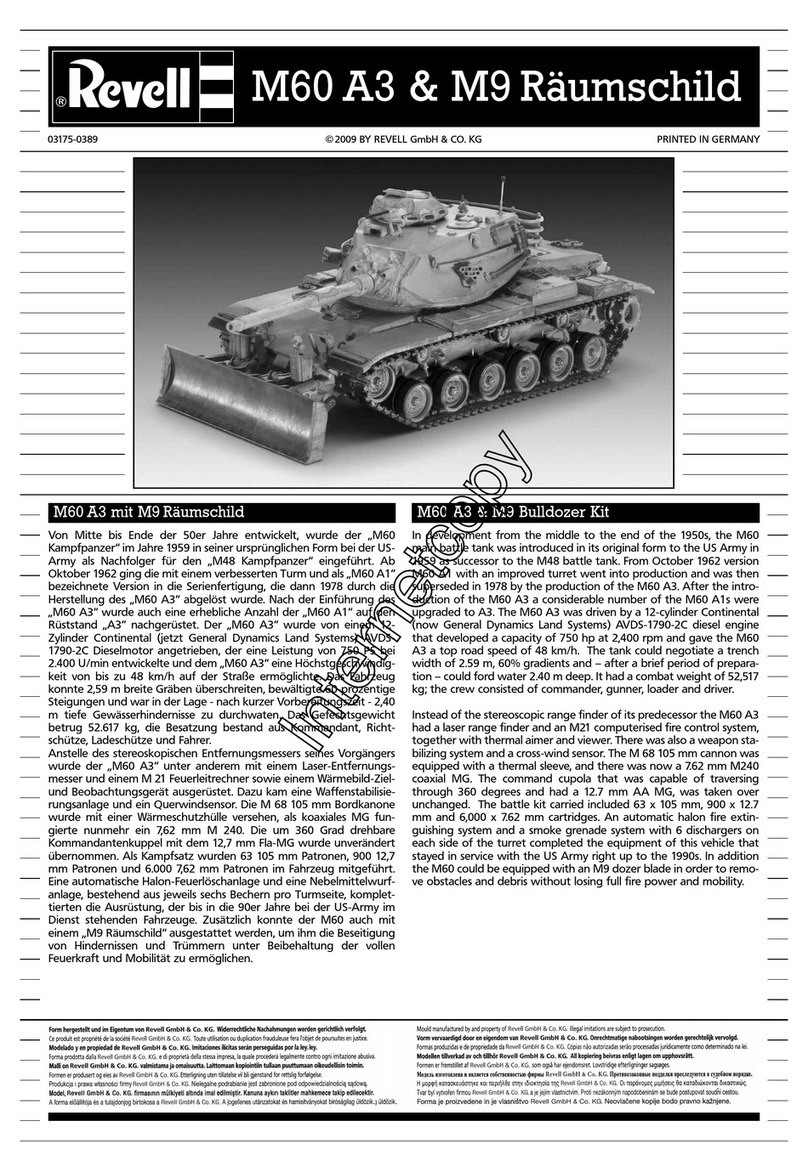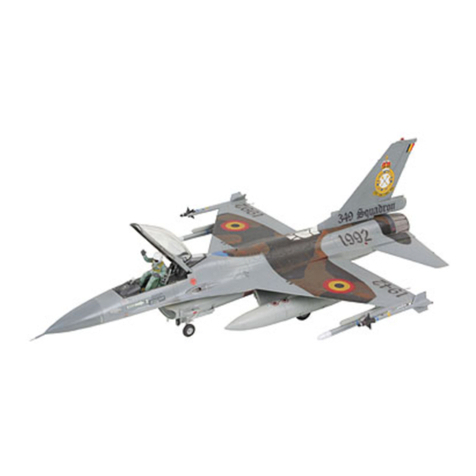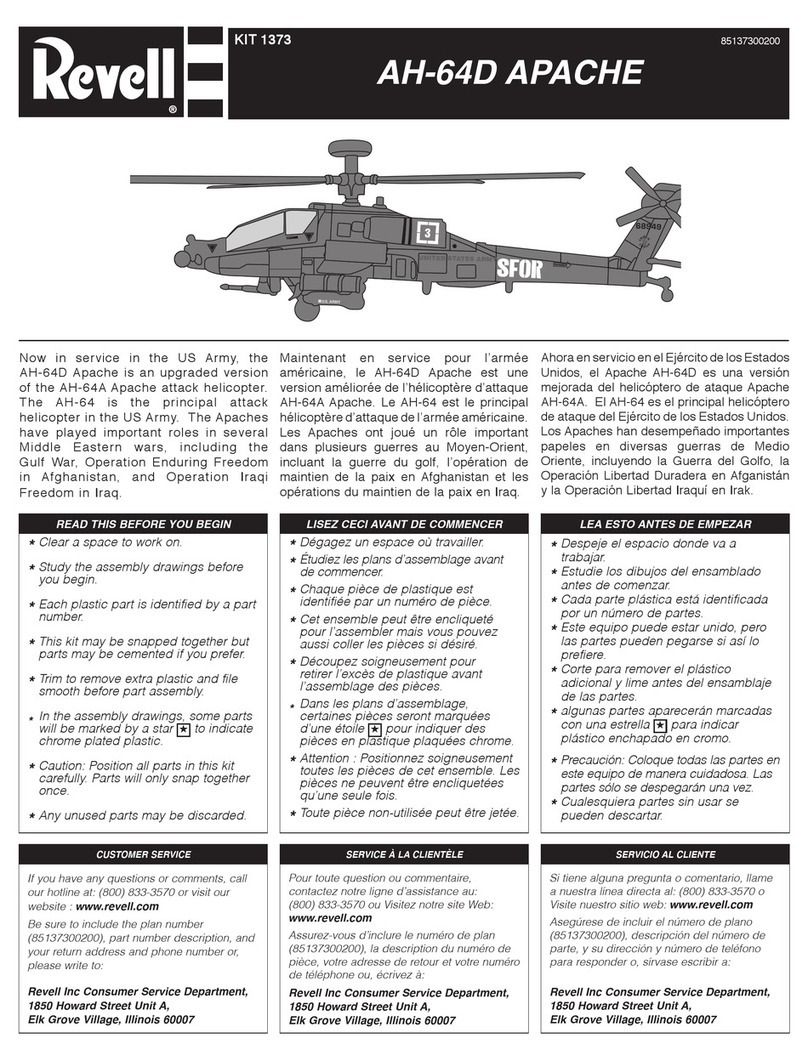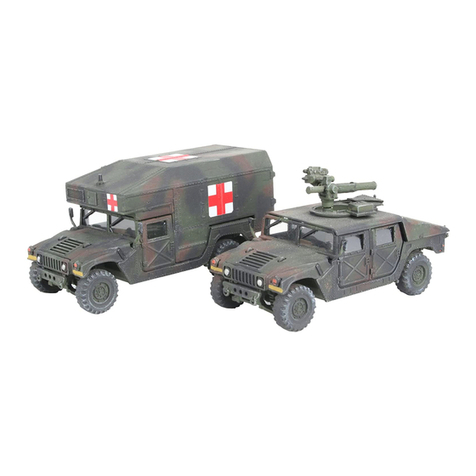Hawker HURRICANE Mk. I Hawker HURRICANE Mk. I
Der Chefkonstrukteur der H.G. Hawker Engineering Co. Ltd., Sidney Camm. entwickelte aus dem Doppeldecker Hawker Fury
seit 1934 das erste Eindeckerjagdflugzeug der Royal Airforce mit einer Höchstgeschwindigkeit von knapp 500 km/h,
Einziehfahrwerk und geschlossenem Cockpit. Mit der „Hurricane“ begann eine neue Era im britischen Flugzeugbau und so
absolvierte der Prototyp erst am 6. November 1936 seinen Erstflug. Die tragende Grundstruktur von Rumpf und Flügel-
mittelteil bestand aus einem verschraubten Rohrgerüst. Die Stahl- und Aluminiumrohre mit Rund- oder Sechseck-Querschnitt
wurden an den Enden rechteckig umgeformt, um mit den massiven Knotenpunkten verbolzt werden zu können. S. Camm
hatte zu dieser Zeit kein Vertrauen in Schweißverbindungen. Von der Kabine bis zum Heck war das Rohrgerüst mit formge-
benden Sperrholzspanten, Holzleisten und Balsaformteilen komplettiert und mit irischem Leinenstoff bespannt. Im
Flügelmittelteil kamen zwei Treibstofftanks hinter dem Hauptfahrwerk zum Einbau. Die Flügelstruktur, die Landeklappen und
Querruder mußten in Handarbeit aus hunderten, vorgeformten Strebenteilen und Rippen montiert und mit Aluminiumblech
beplankt oder mit Stoff bespannt werden. Die Seiten- und Höhenflossen und -ruder wurden ebenfalls mit Stoff bespannt.
Bereits 1937 war die Gemischtbauweise zwar veraltet, brachte jedoch den Vorteil, daß viele kleine Handwerksbetriebe kurz-
fristig als Zulieferfirmen eingeschaltet werden konnten und bei Hawker, der Gloster Aircraft Company und der Austin Motor
Company die Maschinen nur noch endmontiert werden mussten, um ab 1940 die Produktion enorm steigern zu können. Das
hydraulisch einziehbare Hauptfahrwerk verfügte über pneumatisch betätigte Bremsen. Die acht Browning-MG in den Flächen
wurden ebenfalls pneumatisch durchgeladen. Der dazu notwendige Druckluftbehälter im Hauptfahrwerkschacht mußte vor
jedem Start aufgefüllt sein. Ein 12-Zylinder-Flugmotor Rolls-Royce Merlin Mk.II leistete 1030 PS und wirkte auf eine starre
Zweiblattluftschraube. Neben einem vollständig einziehbaren robusten Hauptfahrwerk erhielt das Muster ein nicht einzieh-
bares Spornrad. Am 19. April 1937 begann die Serienfertigung. Die ersten Maschinen wurden im Dezember 1937 bei der 111.
Squadron in den Dienst der RAF übernommen. Die ersten Mk.I hatten stoffbespannte Tragflächen, die ab der Mk.IA durch
eine Aluminium-Halbschalenkonstruktion abgelöst wurden. Im Frühjahr 1940 trafen die „Hurricane“ der RAF erstmals über
Frankreich auf die um 40 km/h schnelleren Messerschmitt Bf 109 E-3. Die deutschen Jäger waren mit ihren Daimler-Benz DB
601 und den 20-mm-Maschinenkanonen mit Sprengmunition klar überlegen. Die Bosch- Benzin-Direkteinspritzung garan-
tierte auch bei ungünstigen Flugmanövern eine maximale Triebwerkleistung. Bei einem RR-„Merlin“-Triebwerk mit Vergaser
kam es dagegen schon bei geringen negativen Beschleunigungswerten durch Treibstoffmangel zu Aussetzern, die bis zum
Motorstillstand führen konnten. Andererseits bewirkte die kleinere Tragfläche der 109 einen größeren Wendekreis. Ein erfah-
rener „Hurricane“-Pilot konnte also durchaus in geringen Höhen gegen eine 109 erfolgreich sein. Einerseits unempfindlicher
bei Treffern mit Explosivgeschossen als die Spitfire, geriet eine „Hurricane“ jedoch ohne selbstdichtende Tanks und mit den
stoffbespannten Holzteilen schnell in Brand. Verheerend wirkte sich deshalb auch ein Vergaserbrand aus, bedenkt man, daß
sich ein großer „Reservetank“ unmittelbar vor dem Cockpit befand. Während der Luftschlacht über England im Sommer und
Herbst 1940 erzielten die 32 „Hurricane“-Staffeln der RAF mit ihren langsameren aber wendigeren Maschinen weit mehr
Abschüsse als die 19 „Spitfire“-Staffeln. Der Bf 109 zwar unterlegen, waren die „Hurricane“ bei der Bekämpfung der einflie-
genden Ju 87, He 111, Do 17 und Ju 88 erfolgreich. Gegenüber der frühen Mk.I verfügten die ab 1939 produzierten Mk.IA
über einen Rolls-Royce „Merlin“ Mk.III mit einstufigem Lader, einem verstellbaren Rotol-Dreiblattpropeller mit konstanter
Drehzahl, einer Frontscheibe aus Panzerglas und den in Schalenbauweise gefertigte Außenflügeln. Ein Novum stellten die bei-
den elektrisch verstellbaren Landescheinwerfer in den Außenflügeln dar. Von der Mk.IA-Version kamen insgesamt 2719
Maschinen im britischen „Fighter Command“ zum Einsatz. Im weiteren Kriegsverlauf verdrängten die moderneren „Spitfire“
die „Hurricane“ bald als Abfangjäger. „Hurricane“-Staffeln bewährten sich später über Malta und Nordafrika als Jäger und
Jagdbomber mit 20- oder 40-mm-Kanonen und Raketengeschossen bei der Panzerjagd und mit Bomben bewaffnet. Um die
Atlantik-Geleitzüge besser gegen die Luftaufklärung und -angriffe der Fw 200 „Condor“ schützen zu können, begann 1941
der Einsatz der ersten 50 zu „Sea Hurricane“ modifizierten Mk.I von Bord einzelner Handelsschiffe, die mit einem Katapult und
allem notwendigen Gerät ausgerüstet wurden. Da eine Rückkehr auf die Schiffe unmöglich war, mußten die Piloten entwe-
der zur Küste fliegen, mit dem Fallschirm abspringen oder neben den Schiffen auf dem Meer landen. Die späteren „Sea
Hurricane“ Mk.IIC mit Rolls-Royce Merlin Mk.XX waren dagegen reine Trägerflugzeuge. - Die Serienproduktion des an sich
veralteten Flugzeuges lief von 1937 bis 1944. Insgesamt entstanden über 14.200 Exemplare in Großbritannien und Kanada.
- Ihre Zuverlässigkeit, Stabilität und gutmütigen Flugeigenschaften sorgten dafür, daß die Maschinen mit besserem Antrieb
und Bewaffnung noch bis zum Kriegsende mit Erfolg zum Einsatz kamen. Die „Hurricane“ Mk.IA, DT-A, serial 6864, wurde
vom Kommandeur der 257.(F) Sqn. F/L Robert „Bob“ Stanford Tuck im Herbst 1940 geflogen. Derzeit gibt es noch 6 flug-
fähige „Hurricane“ verschiedener Versionen.
Technische Daten:
Spannweite: 12,20 m; Länge: 9,59 m; Höhe: 3,96 m; Flügelfläche: 23.93 qm; Leermasse: 2118 kg; Startmasse max.: 2994
kg; Triebwerk: flüssigkeitsgekühlter 12-Zyl.-V- Reihenmotor Rolls-Royce „Merlin“ Mk.III, 623,6 kg Trockenmasse; Hubraum:
27 Liter; Leistung: 1030 PS bei 3000 U/min in 1,5 km Höhe; Propeller: Rotol 3-Blatt-Verstellpropeller, Durchm.: 3276,6 mm;
Treibstoffvorrat: 314 l in 2 Tanks im Flügelmittelteil und 127 l im Reservetank vor dem Cockpit. - Höchstgeschwindigk.:
508 km/h in 6 km Höhe; mittlere Steiggeschw. bis 5 km Höhe: 800 m/min.; Gipfelhöhe: 10.300 m; Reichweite: 845 km;
Bewaffnung: acht 7,7-mm- Browning-MG mit je 330 Schuß.
Since 1934 Sidney Camm, Chief Engineer at H.G. Hawker Engineering Co Ltd had been developing the first single wing fight-
er aircraft for the Royal Air Force out of the Hawker Fury biplane. It had a maximum speed of 500 km/h (270 mph), retractable
under-carriage and enclosed cockpit. When the prototype “Hurricane” completed its maiden flight on 6 November 1936 a
new era in the history of British aircraft construction began.
The main supporting structure of the fuselage and wing center section consisted of a bolted tubular frame construction. The
steel and aluminum tubes with a circular or hexagonal cross section were squared off at the ends so that the massive junc-
tion points could be bolted together. At this moment in time Sidney Camm did not put his trust welded joints.
From the cabin to the tail the tubular structure was shaped with plywood and balsa formers, wooden lathes and finished with
a covering of Irish linen. Two fuel tanks were built into the wing center-section behind the main undercarriage. The wing
frames, flaps and fin had to be assembled by hand from hundreds of preformed laths and rib’s and was finally covered with
aluminum sheet or fabric. The fin, elevators and rudder were also fabric covered.
These mixed construction techniques were outdated as early as 1937; they had however the advantage, that many small
manual working companies could be bought in at short notice. At Hawker, the Gloster Aircraft Company and the Austin
Motor Company, the aircraft only had to be assembled in order to significantly increase the rate of production.
The hydraulically operated retractable main undercarriage also had pneumatically operated brakes. The eight Browning
machine-guns mounted in the wings were also pneumatically loaded. It was therefore necessary to fill the compressed air
tank in the main undercarriage bay before each start.
A 12 cylinder Rolls Royce Merlin Mk II aircraft engine developed 1030hp and drove the fixed two-bladed propeller. As well
as a completely retractable and robust main undercarriage the prototype received a non retractable tail-wheel.
Series production began on 19 April 1937. The first aircraft were taken into service with 111 Squadron RAF in December 1937.
The first Mk1’s had fabric covered wings, which from the Mk1A were replaced with wings of semi-monocoque aluminum
construction. In the spring of 1940 over France, the RAF “Hurricane” first encountered the 40km/h (22 mph) faster
Messerschmitt Bf109E-3.
With their Daimler-Benz DB 601 and 20mm canon firing explosive munitions the German Fighters had a clear superiority. The
Bosch direct petrol injection also guaranteed maximum engine performance during unusual flight maneuvers. In contrast the
Rolls Royce “Merlin” carburetor engine began to lose power and even stalled during small negative “G” maneuvers due to
fuel starvation. On the other hand the smaller wing of the 109 gave it a larger turning circle. It was equally possible that an
experienced Hurricane Pilot could achieve success over a 109 at lower altitudes. On the one hand less susceptible to hits with
high explosive rounds than the “Spitfire”, the “Hurricane” however quickly caught fire with its fabric covered wooden com-
ponents and not having self-sealing fuel tanks. The result of a carburetor fire was therefore also catastrophic, considering that
a large reserve fuel tank was positioned directly in front of the cockpit.
In the summer and autumn of 1940 during the „Battle of Britain“, the 32 Hurricane Squadrons of the RAF achieved many
more „kills“ with their slower and less maneuverable aircraft than the 19 Spitfire Squadrons. Although inferior to the Bf109,
the Hurricane was successful in combat against approaching Ju87, He111, Do17 and Ju88. In contrast to the earlier Mk I, the
Mk IA produced from 1939 onwards had a Rolls Royce “Merlin” Mk III with a single stage compressor, a constant speed three-
blade featherable Rotol propeller, an armoured glass windscreen and outer wings of monocoque construction. New were the
two electrically adjustable landing lamps in the outer wings. Altogether the British “Fighter Command” put 2719 Mk IA’s into
action. - Later on in the war the more modern “Spitfire” soon succeeded the “Hurricane” as a fighter-interceptor. „Hurricane“
Squadrons later proved themselves over Malta and North Africa as Fighter and Fighter-bombers, armed with 20mm or 40mm
canon, rockets and bombs for tank hunting.
In 1941 the first 50 Mk I`s were modified to “Sea Hurricane” specification which enabled them to be launched from the decks
of merchant ships fitted with a catapult and other necessary equipment, in order to better protect Atlantic convoys against
aerial reconnaissance and attack by the Fw 200 „Condor“. Because it was impossible return to the ship and land, the pilot
must either fly to a coastline, jump with his parachute or ditch into the sea alongside a ship. In contrast, the later “Sea
Hurricane“ Mk IIC with a Rolls Royce Merlin Mk XX was a pure carrier aircraft. The production of this simply outdated aircraft
ran from 1937 until 1944. Altogether a total of over 14200 aircraft were built in Great Britain and Canada. - Its reliability, sta-
bility and ease of handling meant that the aircraft, with improved armament and transmission could be successfully deployed
until the end of the war. - Hurricane Mk IA DT-A, serial number 6864 was flown by the Commander of 257(F) Sqn, Flt Lt
Robert “Bob” Stanford Tuck in autumn 1940. At present there are still six “airworthy” Hurricane’s in various versions.
Technical Data:
Wingspan: 12,20 m (40ft 1in); Length: 9.59 m (31ft 5ins); Height: 3.96 m (13ft); Wing Area: 23.93 sqm (257 sq ft); Empty
Weight: 2118 kg (4670lbs); Take-off Weight: 2994 kg (6000lbs); Engine: Liquid cooled 12-Cyl.-V-Inline Rolls-Royce „Merlin“
Mk.III, 623.6 kg (1375lbs) Dry Weight. - Cubic Capacity: 27 Liter; Power: 1030 hp at 3000 rpm at 5000ft. - Propeller: Rotol
3-Blade-adjustable, 10ft 9ins diameter; Fuel Capacity: 314 litres (69 gal) in two tanks in the wing roots and 127 liter (28gal)
in a reserve tank in front of the cockpit. Maximum Speed: 508 km/h (315mph) at 20000 feet; Average Rate of Climb to
5000m (16400ft): 800 m/min (2600ft/min); Service Ceiling: 10.300 m (33784ft); Range: 845 km (525 miles); Armament:
8x Browning 7.7mm MG each with 330 Rounds.
